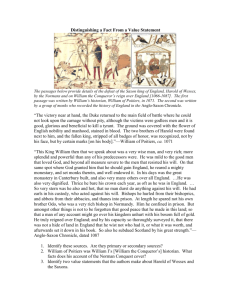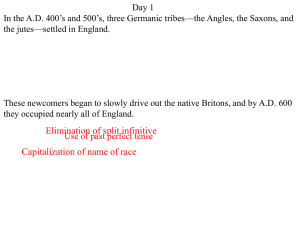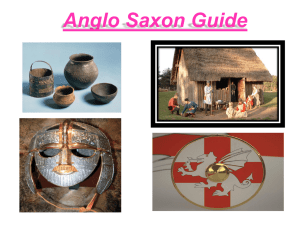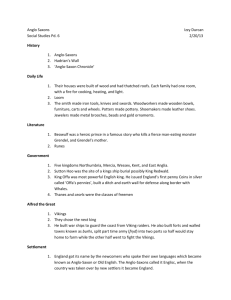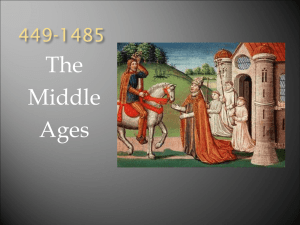Years 5 and 6 Cycle A Anglo-Saxon and Scots Settlements Classes
advertisement
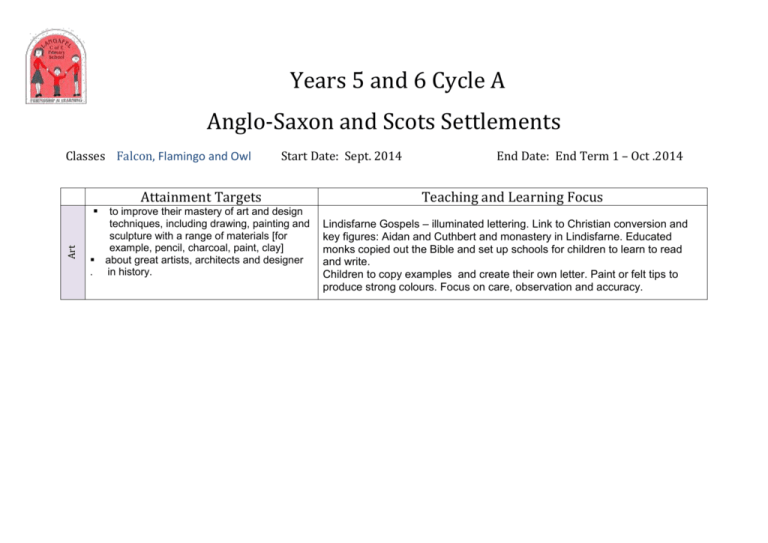
Years 5 and 6 Cycle A Anglo-Saxon and Scots Settlements Classes Falcon, Flamingo and Owl Start Date: Sept. 2014 Attainment Targets End Date: End Term 1 – Oct .2014 Teaching and Learning Focus Art to improve their mastery of art and design techniques, including drawing, painting and sculpture with a range of materials [for example, pencil, charcoal, paint, clay] about great artists, architects and designer . in history. Lindisfarne Gospels – illuminated lettering. Link to Christian conversion and key figures: Aidan and Cuthbert and monastery in Lindisfarne. Educated monks copied out the Bible and set up schools for children to learn to read and write. Children to copy examples and create their own letter. Paint or felt tips to produce strong colours. Focus on care, observation and accuracy. Computing Attainment Targets Teaching and Learning Focus understand computer networks including the internet; how they can provide multiple services, such as the world wide web; and the opportunities they offer for communication and collaboration Research for Topic. Use designated websites to find out about life in Anglo-Saxon times. Also use to research key figures in the Christian movement, such as Augustine. Online access to Sutton Hoo archeology and artefacts. use search technologies effectively, appreciate how results are selected and ranked, and be discerning in evaluating digital content Teach skills of using search engines effectively and safely. Learn about e-safety when using PCs, laptops, i-pads, gaming sites, mobile phones etc., also through PSHCE. use technology safely, respectfully and responsibly; recognise acceptable/unacceptable behaviour; identify a range of ways to report concerns about content and contact DT understand and apply the principles of a healthy and varied diet (different food contains different substances) prepare and cook a variety of predominantly savoury dishes using a range of cooking techniques such as: peeling, chopping, slicing, grating, mixing, spreading, kneading and baking Lifestyle in Anglo-Saxon times: Link to farming – what food was available and predominant. Make a basic bread. What was it made from? How might they have prepared and baked it? Attainment Targets locate the world’s countries, using maps to focus on Europe (including the location of Russia) and North and South America, concentrating on their environmental regions, key physical and human characteristics, countries, and major cities Geography name and locate counties and cities of the United Kingdom, geographical regions and their identifying human and physical characteristics, key topographical features (including hills, mountains, coasts and rivers), and land-use patterns; and understand how some of these aspects have changed over time. human geography, including: types of settlement and land use, economic activity including trade links, and the distribution of natural resources including energy, food, minerals and water use maps, atlases, globes and digital/computer mapping to locate countries and describe features studied Teaching and Learning Focus Identify origins of Angles and Saxons in Europe: Link to Roman occupation of Celtic Britain;L Learn about how and where Angles and Saxons came from; use atlases and maps. Why did they invade our islands and settle here? (Compare to modern day immigration and reasons why other nationalities want to live here.) Why were their settlements in certain areas of the country? Use maps and atlases. Focus on evidence of settlements through place names we use today and their meanings. Use atlases to identify. What other evidence do we have? (Anglo-Saxon Chronicle written by Saxon monks.) Attainment Targets History Britain’s settlement by Anglo-Saxons and Scots Teaching and Learning Focus Identify origins of Angles and Saxons in Europe: Link to Roman occupation of Celtic Britain;L Learn about how and where Angles and Saxons came from; Why did they invade our islands and settle here? (Compare to modern day immigration and reasons why other nationalities want to live here.) Focus on evidence of settlements through place names we use today and their meanings. What other evidence do we have? (Anglo-Saxon Chronicle written by Saxon monks.) See Geography for how these aspects may be covered. What was life like for Anglo-Saxons ? Consider aspects of lifestyle, eg: Housing Food and Farming Clothes/jewellery Tools Role of men/women/children Law and order/social hierarchy Consider historical evidence: Place names Anglo-Saxon Chronicle Burials, especially Sutton Hoo. Attainment Targets listen attentively to spoken language and show understanding by joining in and responding Languages explore the patterns and sounds of language through songs and rhymes and link the spelling, sound and meaning of words Teaching and Learning Focus Recap on vocabulary and phrases already learnt to establish starting point. Ensure secure knowledge and understanding of basics, such as greetings, numbers, colours. Reinforce correct pronunciation. Introduce a few key classroom instructions and responses. Sing songs related to subjects studied. engage in conversations; ask and answer questions; express opinions and respond to those of others; seek clarification and help* speak in sentences, using familiar vocabulary, phrases and basic language structures Music develop accurate pronunciation and intonation so that others understand when they are reading aloud or using familiar words and phrases* listen with attention to detail and recall sounds with increasing aural memory Learn French songs by listening and repetition. Attainment Targets swim competently, confidently and proficiently over a distance of at least 25 metres PE use a range of strokes effectively [for example, front crawl, backstroke and breaststroke] use running, jumping, throwing and catching in isolation and in combination play competitive games, modified where appropriate [for example, badminton, basketball, cricket, football, hockey, netball, rounders and tennis], and apply basic principles suitable for attacking and defending Teaching and Learning Focus Consolidate and improve swimming skills and achievements from last term. Skills of throwing and catching Principles behind invasion games in relation to attacking and defending. Introduce Tag Rugby ( non-contact) 6 week plan developed to build up skills and understanding of the Tag Rugby invasion game. Children self-assess and peer assess and offer constructive criticism to improve skills and game play. Attainment Targets planning different types of scientific enquiries to answer questions, including recognising and controlling variables where necessary Science taking measurements, using a range of scientific equipment, with increasing accuracy and precision, taking repeat readings when appropriate recording data and results of increasing complexity using scientific diagrams and labels, classification keys, tables, scatter graphs, bar and line graphs using test results to make predictions to set up further comparative and fair tests reporting and presenting findings from enquiries, including conclusions, causal relationships and explanations of and degree of trust in results, in oral and written forms such as displays and other presentations Teaching and Learning Focus Not sure how we are allocating Science units over the 2 years. Had thought of Forces in Term 2 (Viking ships?), Materials in Term 3? Attainment Targets PSHCE Consider the reasons for learning and the conditions that promote or inhibit learning and motivation. Develop ideas for our class charter. Teaching and Learning Focus SEAL ‘New Beginnings’: Why do we come to school? What do we need to learn and why? What kind of environment helps us to achieve this? Who is responsible for creating the conditions in which we learn best? Summarise ideas as Class Charter. Children to take pride in presenting their ideas. Explore feelings for starting something new. New pupils; new year group; new classroom; new teacher; new learning challenges: How do these make us feel? How can we deal with those feelings?


